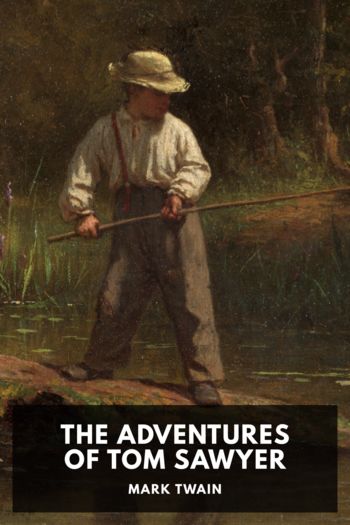The Prince and the Pauper Mark Twain (readict books .TXT) 📖

- Author: Mark Twain
Book online «The Prince and the Pauper Mark Twain (readict books .TXT) 📖». Author Mark Twain
The Famous Stocking Case—A woman and her daughter, nine years old, were hanged in Huntingdon for selling their souls to the devil, and raising a storm by pulling off their stockings! —Dr. J. Hammond Trumbull’s Blue Laws, True and False, p. 20 ↩
Leigh Hunt’s The Town, p. 408., quotation from an early tourist. ↩
From The English Rogue, London, 1665. ↩
Canting terms for various kinds of thieves, beggars and vagabonds, and their female companions. ↩
Enslaving—So young a king and so ignorant a peasant were likely to make mistakes; and this is an instance in point. This peasant was suffering from this law by anticipation; the king was venting his indignation against a law which was not yet in existence; for this hideous statute was to have birth in this little king’s own reign. However, we know, from the humanity of his character, that it could never have been suggested by him. ↩
From The English Rogue, London, 1665. ↩
Death for Trifling Larcenies—When Connecticut and New Haven were framing their first codes, larceny above the value of twelve pence was a capital crime in England—as it had been since the time of Henry I. —Dr. J. Hammond Trumbull’s Blue Laws, True and False, p. 17.
The curious old book called The English Rogue makes the limit thirteen pence ha’penny: death being the portion of any who steal a thing “above the value of thirteen pence ha’penny.” ↩
From many descriptions of larceny the law expressly took away the benefit of clergy: to steal a horse, or a hawk, or woollen cloth from the weaver, was a hanging matter. So it was to kill a deer from the king’s forest, or to export sheep from the kingdom. —Dr. J. Hammond Trumbull’s Blue Laws, True and False, p. 13.
William Prynne, a learned barrister, was sentenced (long after Edward VI’s time) to lose both his ears in the pillory, to degradation from the bar, a fine of 3,000 pounds, and imprisonment for life. Three years afterwards he gave new offence to Laud by publishing a pamphlet against the hierarchy. He was again prosecuted, and was sentenced to lose what remained of his ears, to pay a fine of 5,000 pounds, to be branded on both his cheeks with the letters S. L. (for Seditious Libeller), and to remain in prison for life. The severity of this sentence was equalled by the savage rigor of its execution. —Dr. J. Hammond Trumbull’s Blue Laws, True and False, p. 12 ↩
Hume’s England. ↩
Christ’s Hospital, or Bluecoat School, “the noblest institution in the world”—The ground on which the Priory of the Grey Friars stood was conferred by Henry VIII on the Corporation of London (who caused the institution there of a home for poor boys and girls). Subsequently, Edward VI caused the old Priory to be properly repaired, and founded within it that noble establishment called the Bluecoat School, or Christ’s Hospital, for the education and maintenance of orphans and the children of indigent persons … Edward would not let him (Bishop Ridley) depart till the letter was written (to the Lord Mayor), and then charged him to deliver it himself, and signify his special request and commandment that no time might be lost in proposing what was convenient, and apprising him of the proceedings. The work was zealously undertaken, Ridley himself engaging in it; and the result was the founding of Christ’s Hospital for the education of poor children. (The king endowed several other charities at the same time.) “Lord God,” said he, “I yield Thee most hearty thanks that Thou hast given me life thus long to finish this work to the glory of Thy name!” That innocent and most exemplary life was drawing rapidly to its close, and in a few days he rendered up his spirit to his Creator, praying God to defend the realm from Papistry. —J. Heneage Jesse’s London: Its Celebrated Characters and Places.
In the Great Hall hangs a large picture of King Edward VI seated on his throne, in a scarlet and ermined robe, holding the sceptre in his left hand, and presenting with the other the Charter to the kneeling Lord Mayor. By his side stands the Chancellor, holding the seals, and next to him are other officers of state. Bishop Ridley kneels before him with uplifted hands, as if supplicating a blessing on the event; whilst the Aldermen, etc., with the Lord Mayor, kneel on both sides, occupying the middle ground of the picture; and lastly, in front, are a double row of boys on one side and girls on the other, from the master and matron down to the boy and girl who have stepped forward from their respective rows, and kneel with raised hands before the king. —Timbs’ Curiosities of London, p. 98.
Christ’s Hospital, by ancient custom, possesses the privilege of addressing the Sovereign on the occasion of his or her coming into the City to partake of the hospitality of the Corporation of London. —Timbs’ Curiosities of London
The Dining Hall, with its lobby and organ-gallery, occupies the entire storey, which is 187 feet long, 51 feet wide, and 47 feet high; it is lit by nine large windows, filled with stained glass on the south side; and is, next to Westminster Hall, the noblest room in the metropolis. Here the boys, now about 800 in number, dine; and here are held the “Suppings in Public,” to which visitors are admitted by tickets issued by the Treasurer and by the Governors of Christ’s Hospital. The tables are laid with cheese in wooden bowls,





Comments (0)